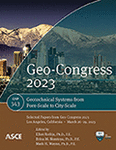Post-Construction Monitoring of Rehabilitated Highway Embankment Slope in Texas
Publication: Geo-Congress 2023
ABSTRACT
Highway embankments built with expansive soils often undergo shallow slope failure due to permanent deterioration of soil’s hydromechanical properties owing to its shrink-swell behavior. The alternate wetting and drying cycles result in the development of desiccation cracks, increase in water infiltration, and subsequent reduction in shear strength. This study provides an overview of the forensic analysis of the rehabilitation work performed on a failed highway embankment near North Texas. The rehabilitation of the embankment was performed by considering the detrimental effects of wet–dry cycles, and perched water table in the slope during rainfall events. The surficial layer was treated with lime and a subsurface drainage system was installed during the rehabilitation. A post-rehabilitation data-monitoring framework was developed and comprehensive analyses are presented to validate the effectiveness of treatment considering the temporal deformation and moisture content. Vertical deformation was monitored using Terrestrial LiDAR Scanners (TLS) and total station. Temporal deformation data showed marginal vertical deformation of embankment and the overlying pavement. Moisture sensor data illustrated minimal changes in volumetric water content of the treated layer, below the treated layer, and of the native soil. The deformation and moisture results align well with the expected performance and validate the efficacy of the surficial lime treatment with a drainage system for a long-term durable performance of the rehabilitated embankment.
Get full access to this article
View all available purchase options and get full access to this chapter.
REFERENCES
Abrams, T. G., and Wright, S. G. (1972). A Survey of Earth Slope Failures and Remedial Measures in Texas. Center for Highway Research, University of Texas at Austin, Austin, TX.
Abramson, L. W., Lee, T. S., Sharma, S., and Boyce, G. M. (2001). Slope Stability and Stabilization Methods. John Wiley and Sons Inc.
Albrecht, B. A., and Benson, C. H. (2001). “Effect of desiccation on compacted natural clays.” Journal of Geotechnical and Geoenvironmental Engineering, 127(1), 67–75.
Bell, F. G. (1996). “Lime stabilization of clay minerals and soils.” Engineering Geology, 42(4), 223–237.
Biswas, N., Puppala, A. J., Chakraborty, S., and Khan, M. A. (2021a). “Utilization of Silica-Based Admixture to Improve the Durability of Lime-Treated Expansive Soil.” IFCEE 2021, 233–242.
Biswas, N., Puppala, A. J., Khan, M. A., Congress, S. S. C., Banerjee, A., and Chakraborty, S. (2021b). “Evaluating the Performance of Wicking Geotextile in Providing Drainage for Flexible Pavements Built over Expansive Soils.” Transportation Research Record: Journal of the Transportation Research Board, 036119812110013.
Boluk, B., Chakraborty, S., Puppala, A. J., and Jafari, N. H. (2022). Inverse Analysis of a Failed Highway Embankment Slope in North Texas. Lecture Notes in Civil Engineering, Springer International Publishing.
Boluk, B., Puppala, A. J., Chakraborty, S., and Bhaskar, P. (2021). “Forensic analyses and rehabilitation of a failed highway embankment slope in texas.” Transportation Research Record, 2675(8), 121–134.
Consoli, N. C., Lopes, L. D. S., Prietto, P. D. M., Festugato, L., and Cruz, R. C. (2011). “Variables Controlling Stiffness and Strength of Lime-Stabilized Soils.” Journal of Geotechnical and Geoenvironmental Engineering, 137(6): 628–632.
Chakraborty, S., Puppala, A. J., and Biswas, N. (2022). “Role of crystalline silica admixture in mitigating ettringite-induced heave in lime-treated sulfate-rich soils.” Géotechnique, 72(5), 438–454.
Faro. (2021). “How the Focus3D 330 Works.” <https://eastcoastmetrology.com/inventory/metrology-equipment/faro-laser-scanner-focus3d-330/?keyword=&creative=519865940098&gclid=Cj0KCQiAnuGNBhCPARIsACbnLzo-JELbgmyaj4Fvu5ZD9CvIk4-LUj3AhfllatKYueTzSn5lVUqHFwgaAv9ZEALw_wcB>(Dec. 14, 2021).
George, A. M., Chakraborty, S., Das, J. T., Pedarla, A., and Puppala, A. J. (2018). “Understanding Shallow Slope Failures on Expansive Soil Embankments in North Texas Using Unsaturated Soil Property Framework.” PanAm Unsaturated Soils 2017, Proceedings, 206–216.
Jafari, N. H., and Puppala, A. J. (2018). Prediction and Rehabilitation of Highway Embankment Slope Failures in Changing Climate. Transportation Consortium of South-Central States (Tran-SET).
Jang, J., Biswas, N., Puppala, A. J., Congress, S. S. C., Radovic, M., and Huang, O. (2022a). “Evaluation of Geopolymer for Stabilization of Sulfate-Rich Expansive Soils for Supporting Pavement Infrastructure.” Transportation Research Record: Journal of the Transportation Research Board, 2676(9), 230–245.
Jang, J., Puppala, A. J., Biswas, N., Chakraborty, S., and Radovic, M. (2022b). “Utilization of Metakaolin-Based Geopolymers for Stabilization of Sulfate-Rich Expansive Soils.” Geo-Congress 2022, American Society of Civil Engineers, Reston, VA, 222–231.
Kayyal, M. K., and Wright, S. G. (1991). Investigation of long-term properties of Paris and Beaumont clays in earth embankment. Center for Transportation Research, University of Texas at Austin, Austin, TX.
McCleskey, K. L. (2005). Experimental Investigations to Select Stabilization Methods to Mitigate Desiccation Cracks in order to Reduce Slope Failures. University of Texas at Arlington, Arlington, TX.
Peron, H., Hueckel, T., Laloui, L., and Hu, L. B. (2009). “Fundamentals of desiccation cracking of fine-grained soils: Experimental characterisation and mechanisms identification.” Canadian Geotechnical Journal, 46(10), 1177–1201.
Puppala, A. J., and Pedarla, A. (2017). “Innovative ground improvement techniques for expansive soils.” Innovative Infrastructure Solutions, 2(1), 24.
Rayhani, M. H. T., Yanful, E. K., and Fakher, A. (2007). “Desiccation-induced cracking and its effect on the hydraulic conductivity of clayey soils from Iran.” Canadian Geotechnical Journal, 44(3), 276–283.
Shafikani, A., Bheemasetti, T. V., and Puppala, A. J. (2018). “Performance Evaluation of a Bridge Infrastructure Using Terrestrial Laser Scanning Technology.” Geotechnical testing journal, ASTM International, 42(6), 1587–1605.
Tang, C.-S., Shi, B., Liu, C., Gao, L., and Inyang, H. I. (2011). “Experimental Investigation of the Desiccation Cracking Behavior of Soil Layers during Drying.” Journal of Materials in Civil Engineering, 23(6), 873–878.
USDA. (2018). “Texas NAIP Imagery, 2018-12-31. Web. 2021-11-23.”
USGS. (2018). “Texas West Central Lidar, 2018-05-27. Web. 2021-11-23.”
Information & Authors
Information
Published In
History
Published online: Mar 23, 2023
Authors
Metrics & Citations
Metrics
Citations
Download citation
If you have the appropriate software installed, you can download article citation data to the citation manager of your choice. Simply select your manager software from the list below and click Download.
